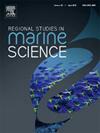Characteristics of meiofaunal communities inhabiting waters surrounding marine research stations based in the Yellow Sea and East China Sea
IF 2.1
4区 环境科学与生态学
Q3 ECOLOGY
引用次数: 0
Abstract
This study aimed to analyze meiofaunal communities near three marine research stations (MRSs) installed in the Yellow Sea to identify the characteristics of meiofaunal communities in subtidal zones. The study was conducted using samples collected near Ieodo MRS (I-MRS), Gageocho MRS (G-MRS), and Socheongcho MRS (S-MRS) located on the southern, central, and northern parts of the Yellow Sea, respectively. The average distribution density of meiofauna was 118.9 ± 11.1 Inds./10 cm2 in 2016 and 237.4 ± 33.7 Inds./10 cm2 in 2020 near I-MRS; 65.9 ± 12.5 Inds./10 cm2 in 2017 near G-MRS; and 196.9 ± 32.8 Inds./10 cm2 in 2018 and 392.5 ± 41.8 Inds./10 cm2 in 2019 near S-MRS. The range of these abundances is similar to those observed in the subtidal zones of the Yellow Sea. The results showed that the distribution density of meiofauna was high near the S-MRS but low near the G-MRS, which had fine-grained sediments and higher TOC content than the other MRSs. The mean number of meiofaunal taxa observed was 6.9 in 2016 and 8.9 in 2020 near I-MRS; 5.4 in 2017 near G-MRS; 8.8 in 2018 and 9.5 in 2019 near S-MRS. The G-MRS region, characterized by fine sediment, had the highest proportion of nematodes, the lowest abundance of harpacticoids among all MRS regions. Also the analysis of meiofaunal abundance by size revealed that there are higher and lower proportions of small-sized and large-sized meiofaunal individuals than the other MRS areas. A cluster analysis confirmed that the meiofaunal communities form distinct groups based on the locations of the MRSs. Correlation analysis between sediment environmental factors and distribution density of meiofauna revealed a significant negative correlation between sediment grain size and TOC content.
求助全文
约1分钟内获得全文
求助全文
来源期刊

Regional Studies in Marine Science
Agricultural and Biological Sciences-Ecology, Evolution, Behavior and Systematics
CiteScore
3.90
自引率
4.80%
发文量
336
审稿时长
69 days
期刊介绍:
REGIONAL STUDIES IN MARINE SCIENCE will publish scientifically sound papers on regional aspects of maritime and marine resources in estuaries, coastal zones, continental shelf, the seas and oceans.
 求助内容:
求助内容: 应助结果提醒方式:
应助结果提醒方式:


